The metaverse, regarded as the next generation of the internet, is where the real and virtual worlds meet. The technology provides a space for endless, interconnected virtual communities. All by using virtual reality (VR) headsets, augmented reality (AR) glasses, smartphone apps, or other devices. It allows digital representations of people, known as avatars. They can interact with each other in various settings, at work, in the office, attending concerts or sports events, or trying on clothes. Evidently, various Metaverse companies are strengthening its future.
But before we see what the future of the metaverse holds, let’s look into its brief history.
History of the Metaverse
Neal Stephenson coined the term ‘metaverse’ in his 1992 science fiction novel Snow Crash. Here humans interact with each other as avatars. In Stephenson’s novel, the metaverse is a digital universe that can be accessed through VR. Since then, several sci-fi works have used it as a plot. This includes popular movies such as Ready Player One, The Matrix franchise, and games like Second Life. (Source)
The Metaverse Today
In recent years, Mark Zuckerberg’s repeated references and ultimately rebranding of its company to Meta boosted the tech to a great extent. Other big companies also jumped in the race, which increased the market value of Metaverse.
In 2021, the global metaverse market was expected to be worth USD 38.85 billion. From 2022 to 2030, it is expected to grow at a compound annual growth rate (CAGR) of 39.4%. A growing emphasis on integrating the digital and physical worlds via the Internet. The increasing momentum and popularity of Mixed Reality (MR), Augmented Reality (AR), and Virtual Reality (VR), and the outbreak of COVID-19, as well as the situation’s subsequent developments and outcomes, are expected to drive revenue growth. (Source)
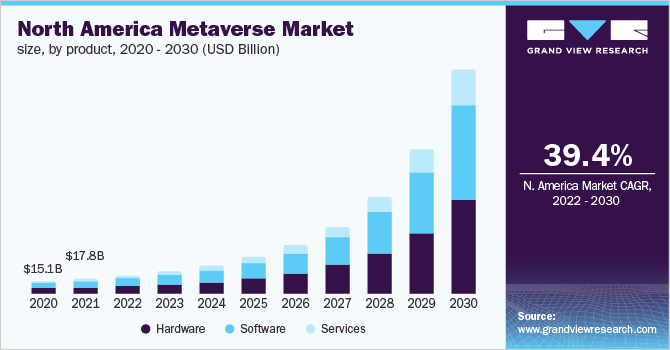
These factors make it one of the top researched technology worldwide. Various companies are spending a large amount of money in R&D to gain a further lead in the Metaverse global market for any segment, be it software, hardware, or services.
To find more, let’s see the 10 companies that are doing intense research in the Metaverse:
1. Meta
Facebook (Meta) entered into the metaverse with the acquisition of Oculus for $2 billion in 2014. Through this acquisition, the tech giant intended to expand Oculus’ virtual reality capabilities beyond gaming to sectors like communications, media, entertainment, and education.
According to Mark Zuckerberg, CEO of Meta, “Mobile is today’s platform, and now we’re also getting ready for the platforms of tomorrow. Oculus has the chance to create the most social platform ever, and change the way we work, play, and communicate.” (Source)(Source)
In March 2022, Meta, announced a $1 billion investment in a new data center in Spain. The company plans to help establish the foundation of its metaverse, as well as has intentions to recruit 2,000 people in the area to boost development. According to the corporation, construction of the new data center will be complete by 2023 but it will not be operational until 2029.
Products Related to Metaverse
Oculus Quest – Oculus Quest revolutionized wireless VR. Facebook unveiled Oculus Quest 2, the next generation of all-in-one VR, in September 2020. With a redesigned all-in-one form size, new Touch controllers, and the highest-resolution display ever, Quest 2 advances the state of VR. The Meta Quest 2 (previously known as Oculus Quest 2) also needs a Facebook login and acceptance of Meta’s device terms of service.

Meta also stated that beginning in 2022, Quest 2 users would no longer be needed to connect with Facebook to use the headset. New users would not be required to connect their Facebook accounts to their headsets, and current users would be able to unlink their Facebook accounts while preserving all of their account information and transactions. (Source)(Source)

Horizon Worlds – in 2021 Facebook revealed its initial idea of a metaverse home base, Horizon Home. When consumers put on their Quest headset, this is the first object they see. Horizon Home was the most recent addition to Horizon, a Facebook social network that allowed individuals to create and connect in the metaverse. It joined Horizon Worlds, currently available in beta, and Horizon Workrooms, Facebook’s flagship productivity solution. (Source)(Source)

M&As Related to Metaverse
- Facebook (Meta) announced a collaboration with VNTANA in March 2022 to introduce 3D advertising to Facebook and Instagram. VNTANA has been provided access to Meta’s AR publishing application programming interface to automate 3D advertising technologies.
- This latest agreement serves as a springboard for Meta to expand its advertising business into the metaverse. Brands could promote 3D representations of their items on Facebook and Instagram, bringing in a whole new age of customer-business connections. (Source)
- In October 2021, Meta collaborated with Israeli company Spike to offer one of its first 2D productivity apps on its virtual reality platform. The Spike application assists in converting standard emails into chat-like interactions.
- Oculus store recently added Spike. It is currently available on the Oculus Quest 2 VR headset and works on iPhones, Android smartphones, Macs, and PCs.
According to Spike, “Spike’s 2D app on Oculus Quest 2 brings Spike’s next-generation communication and collaboration features into a virtual desk where your productivity is virtually unlimited.” (Source)(Source)
- Verizon announced a strategic collaboration with Facebook (Meta) in March 2022 to investigate various metaverse opportunities. Along with Meta’s technology, the new cooperation would investigate Verizon’s 5G Ultra-Wideband network and mobile edge computer (MEC) capabilities.
According to Rima Qureshi, Chief Strategy Officer at Verizon, “This [partnership] is to understand the foundational requirements for the metaverse and its applications. Our collaboration with Meta will explore how Verizon’s MEC infrastructure can deliver intensive XR cloud rendering and low latency streaming.” (Source)(Source)
Strategy Related to The Metaverse
In September 2021, Facebook announced that a ‘fully realized’ metaverse would be available within the next 10 to 15 years and would invest $50 million in a worldwide research effort to build it ‘responsibly.’
Facebook plans to collaborate with ‘civil rights groups, governments, non-profits, and academic institutions to determine how to create these technologies responsibly using its $50 million investment (which equates to 0.05% of its 2020 annual sales of $85.9 billion). (Source)
In 2021, Facebook developed Horizon Workrooms with Oculus headsets, which displays avatars of everyone in a meeting chatting to one other as if they were truly present in a virtual reality area. Horizon Workrooms is the first step toward a virtual reality ‘metaverse.’ Zuckerberg’s ambition with Oculus is to leap directly from smartphones and laptops to VR headgear to engage billions of Facebook users in a more immersive way. (Source)(Source)
Metaverse Monetization Plans
Facebook’s monetization strategy includes selling hardware since 2021, but that is not where the actual revenue is generated. During the earnings call, Zuckerberg said that Facebook’s objective is to sell its headsets as inexpensively as possible while focusing on generating money from commerce and advertising inside the metaverse.
Zuckerberg said that advertising in the metaverse would be “an important part” of Facebook’s strategy to profit from the metaverse, but he was more optimistic about commerce in the digital world.
According to Mark Zuckerberg, CEO of Meta, “Our business model isn’t going to primarily be around trying to sell devices at a large premium or anything like that because our mission is around serving as many people as possible. So we want to make everything that we do as affordable as possible, so as many people as possible can get into it and then compounds the size of the digital economy inside it.” (Source)
2. Microsoft
Microsoft entered Metaverse with its acquisition of Mojang. In Nov 2014, Microsoft bought Mojang to make Minecraft a significant element of the company’s Metaverse plans. In 2017, Microsoft purchased AltspaceVR with the express intent of exploiting its IP for Mesh.
Microsoft first revealed its Mesh product in March 2021, then on November 2, 2021, during Ignite, Microsoft revealed that Mesh for Teams is presently available. Mesh allows people to connect with a holographic presence, share content across space, and collaborate from any location. Mesh offers a realistic mixed-reality collaborative experience, with 3D avatars representing people in a shared area.
Microsoft acquired Activision Blizzard for $68.7 billion on January 18, 2022, which would help Microsoft to build blocks for the metaverse. (Source)(Source)(Source)(Source)(Source)
Amadeus, a travel technology company, announced in December 2021 that they’d soon introduce new features that connect to Microsoft’s enormous network of productivity applications, such as harnessing its Xbox gaming console’s virtual reality capabilities to explore the metaverse.
In February 2021, Amadeus and Microsoft forged a strategic collaboration. Nine months into the agreement, it is still winding down its data center in Erding, Germany, and transitioning to Microsoft’s Azure cloud infrastructure. (Source)
Microsoft Products Related to Metaverse
HoloLens – The HoloLens V1 (first generation) was first revealed in 2015, and pre-orders were available by 2016. However, it was discontinued later.
Microsoft officially released Windows Mixed Reality and a line of third-party immersive headgear called Windows Mixed Reality immersive headsets in October 2017.
The Microsoft Ignite event announced the availability of HoloLens 2 in November 2019. (Source)(Source)(Source)
Mesh – Microsoft announced in 2021 that it would be tightly integrated with the Teams platform to facilitate VR-based communication. Mesh is a comprehensive virtual environment that can be accessed by various devices, with several sub-worlds and digital assets to give a realistic experience. It is a Microsoft mixed-reality overlay that enables Teams users to interact in virtual environments, work with persistent 3D material, and access Teams via mixed-reality glasses and VR headsets. It combines several crucial features and capabilities to provide users with a completely immersive collaboration experience. (Source)
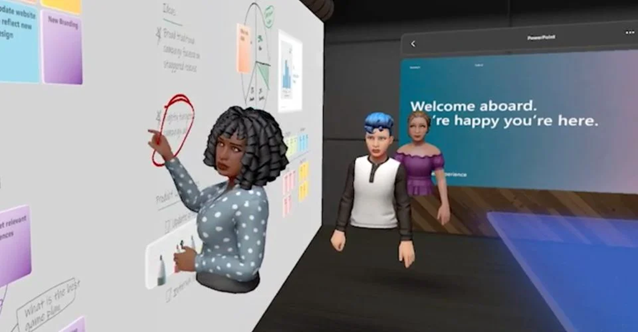
Azure Blockchain – Microsoft released Azure Blockchain Solution, a fully managed service for forming, managing, and governing consortium blockchain networks, in 2019. Based on recent changes in the blockchain sector and the rising business needs of clients, Microsoft terminated Azure Blockchain Service in September 2021. (Source)(Source)
Azure Blockchain Architecture

M&As Related to Metaverse
- In January 2022, Qualcomm Technologies, Inc. announced a collaboration with Microsoft to expand and accelerate augmented reality (AR) use in both the consumer and corporate sectors.
Qualcomm Technologies has been collaborating with Microsoft on several initiatives to drive the ecosystem, including the development of custom AR chips to enable a new wave of power-efficient, lightweight AR glasses to deliver rich and immersive experiences, as well as plans to integrate software such as Microsoft Mesh and the Snapdragon SpacesTM XR Developer Platform. This cooperation validates Qualcomm Technologies’ established spatial computing expertise, technological leadership, and drive to create revolutionary experiences for the next generation of head-worn AR devices as they enter the metaverse.
- In Jan 2022, Microsoft acquired Activision Blizzard Inc. for $68.7 billion. This purchase would drive Microsoft’s game business development across mobile, PC, console, and cloud platforms and supply building pieces for the metaverse.
According to Satya Nadella, Chairman and CEO of Microsoft, “Gaming is the most dynamic and exciting category in entertainment across all platforms today and will play a key role in the development of metaverse platforms. We’re investing deeply in world-class content, community, and the cloud to usher in a new era of gaming that puts players and creators first and makes gaming safe, inclusive, and accessible to all.” (Source)
Strategy Related to The Metaverse
- Microsoft announced in November 2021 that it intended to offer its Metaverse and Avatar toolset (Microsoft Mesh) for Teams, which would be available in mid-2022, and would allow individuals to replace their video presence with an avatar, construct virtual rooms, and integrate 3D places in Teams. Teams may be used to power a trade show, a learning conference, or a 3D onboarding experience. (Source)(Source)
- Microsoft is concentrating its focus on Mesh, a platform that would power Teams and other apps, and HoloLens, an augmented reality system extensively used in industry, education, and the military. Microsoft intends to make Metaverse applications available in business, education, training, and entertainment. Avatars, VR, and AR will improve and reimagine these real-world requirements. (Source)
Metaverse Monetization Plans
Microsoft bought Activision Blizzard for $68.7 billion in January 2022. Microsoft’s owner indicated in a news statement outlining its intention that this transaction would supply building blocks for the metaverse. According to the company, gamers could smoothly monetize the metaverse and become early adopters, pushing it into the mainstream.
Microsoft intends to convert such games from 2D to full 3D. Activision Blizzard and Xbox are already preparing to join the VR gaming market. (Source)(Source)
3. Google
Google made its first step in the metaverse with Google Glass, which debuted in 2012, and provided an augmented reality experience by combining visual, audio, and location-based inputs to deliver pertinent information. (Source)
Later, Google joined the virtual reality bandwagon by introducing Google’s Cardboard gadget platform, initially introduced in 2014. It was a smartphone VR viewer made from cardboard at a reasonable cost. (Source)
In 2018, Google launched new features for its augmented reality system ARCore and made its Lens visual search engine available on all phones. (Source)
Google also stretched its hands to Google Cloud, an Alphabet division, and is currently building a team to attract blockchain business, as it may accept cryptocurrency payments in the future. (Source)
Google is working on an AR headset named Project Iris launching by 2024. (Source)
Google includes a portfolio of projects focused on fundamental research, new product innovation, product contribution, and infrastructure objectives while enabling individuals and teams to concentrate on specific types of work.
Some of the most exciting research allows for the development of new goods and enterprises. Atlanta, Cambridge, Seattle & Kirkland, Amsterdam, London, Paris, Israel, Switzerland, Australia, India, and Tokyo are just a few locations where Google Research conducts research, including AR, VR, and metaverse-related research. (Source)
Products Related to Metaverse
Google ARCore – In 2018 Google launched its augmented reality platform, ARCore that enables users to build their own augmented reality experiences. Through several APIs, ARCore enables users’ phones to see their surroundings, understand the environment, and interact with information. The motion tracking technology in ARCore utilizes the phone’s camera to find interesting points, known as features, and monitors how those points move over time. ARCore calculates the location and orientation of the phone as it travels across space using a combination of the movement of these points and information from the phone’s inertial sensors. (Source)
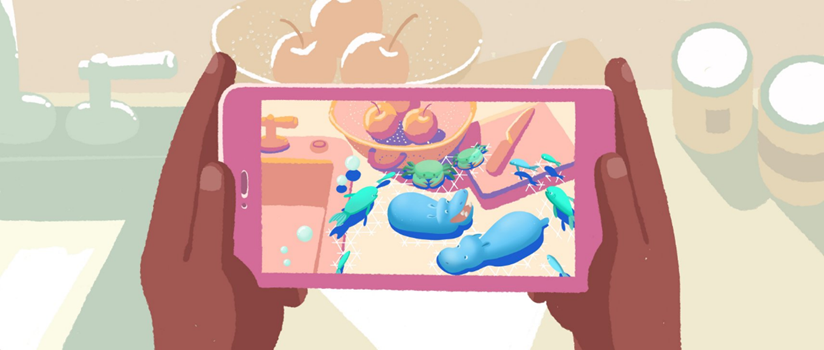
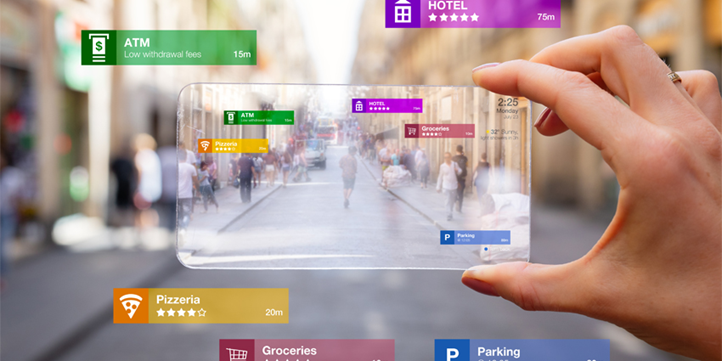
Google Earth VR – Google Earth VR, released in 2016, enables users to explore the world from new perspectives. Virtual reality software lets users experience cities, landmarks, and natural wonders from across the globe. Users of Earth VR may fly over a city, stand on the tallest peaks, and even soar into space. (Source)(Source)
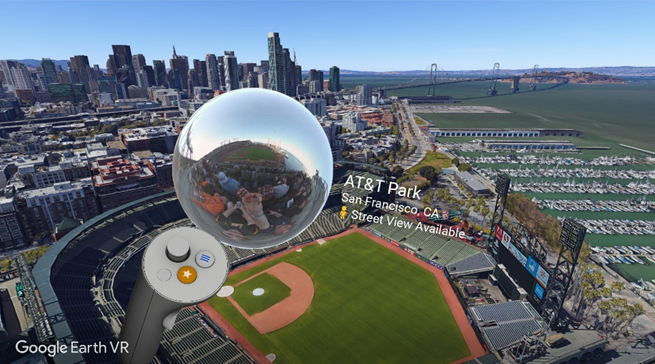

Project Iris – Google is developing Project Iris, an augmented reality headset that will be available in 2024. Google’s product combines computer graphics with a video stream of the actual world, resulting in a more immersive, mixed-reality experience than previous AR glasses like Snap and Magic Leap. Early versions developed in a San Francisco Bay Area facility resemble a pair of ski goggles and do not need a tethered connection to an external power source. (Source)
Google M&A Related to Metaverse
- Google invested $1 billion in March 2022 to acquire Raxium, a company that manufactures MicroLED displays and has made substantial advances in augmented reality displays.
According to Guillaume Chansin, Director of Display Research at DSCC, “MicroLED can be much brighter than OLED. This is particularly important for AR smart glasses that will be used outdoors. MicroLED has the potential to deliver high resolution, high contrast, and high brightness. This is why it has become a strategic investment for tech companies working on smart glasses.” (Source)
- Google announced the acquisition of North, an Amazon-backed startup that manufactures smart eyewear, in 2020. The deal’s value was not revealed, but the Globe and Mail, which originally reported Google’s interest, estimated it to be $180 million.
According to Rick Osterloh, Senior Vice President of Devices and Services at Google, “We’re building towards a future where helpfulness is all around you, where all your devices just work together and technology fades into the background. North’s technical expertise will help as we continue to invest in our hardware efforts and ambient computing future.” (Source)
- Huahan, a Foxconn Group company in Taiwan, stated in January 2022 that Google had invested NT$1.1 billion (US$39.5 million) in its private equity fund for metaverse initiatives. Currently, Google has a 4.6% ownership in the fund, making it the third-largest corporate investor. According to a UDN report, the fund infusion would enhance software and hardware integration for metaverse platforms. (Source)
4. Sony
Sony started its metaverse journey in 2015 with Sony SmartEyeglass, a set of professional, smart AR glasses released by Sony. To overlay information, these augmented reality smart glasses utilize hologram optics technology. (Source)
PlayStation VR debuted in 2016 and rapidly became the best-selling high-end VR headset. Sony said in August 2018 that it sold more than three million PSVR devices and 21.9 million VR games and apps. (Source)
The PlayStation VR aim controller, introduced in 2017, transforms into a weapon in the virtual world. Sony is presently working on PlayStation VR2, a successor to PlayStation VR, which is expected to be published by the end of 2022. (Source)
The Sony R&D Center is the Sony Group Corporation’s research and development unit. Engineers from all over the world come together to explore new ways to inspire the next generation and create social value through distinctive R&D initiatives and are in charge of using technology and skills to create emotion and social value.
The research center carries out a variety of studies, including game and network services. Sony has R&D located around the world, such as San Jose in California, Beijing in China, Brussels in Belgium, Bangalore and Mumbai in India, Stuttgart in Germany, Lund in Sweden, and Tokyo in Japan. (Source)
Products Related to Metaverse
SmartEyeglass – Sony’s SmartEyeglass, introduced in 2015, is a pair of professional, smart AR glasses made by Sony. These augmented reality smart glasses (or smart glasses) use holographic optics technology to overlay information. (Source)

PlayStation VR – The PlayStation VR is a virtual reality headset released in October 2016 by Sony Interactive Entertainment and is the best-selling high-end VR headset. (Source)

Wanderer and Zenith – Wanderer, a brand-new time-traveling PSVR adventure game from indie game companies Oddboy and M Theory, was revealed by Sony in January 2022. The company has also announced Zenith, an open-world MMO for PlayStation VR that combines colorful aesthetics with engaging action-adventure gameplay. (Source)(Source)
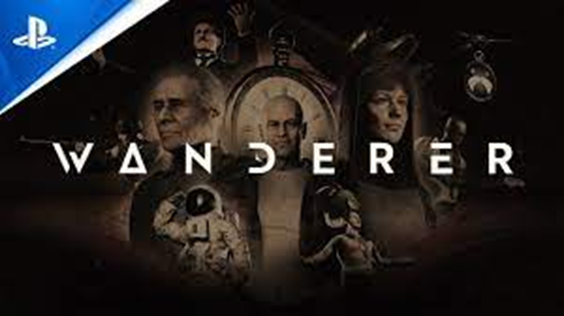
M&As Related to Metaverse
- Sony and Niantic, Inc., a company that makes and distributes augmented reality (AR) mobile games, announced cooperation on auditory AR for headphones in February 2022. With this partnership, both firms would accelerate new research efforts in augmented reality gaming to offer a more immersive gaming experience when paired with headphones.
Sony also stated that their first venture, ‘Ingress,’ would be released in 2022, allowing users to experience auditory AR using Sony’s fully wireless headphones. (Source)
- Sony acquired Bungie, a video game company, in February 2022 for $3.6 billion. Bungie is well-known for its multiplayer platform games, and also has a significant existence in the metaverse. In addition, they would collaborate with PlayStation Studios to boost live-action gameplay and community growth. (Source)
Strategy Related to The Metaverse
- According to Epic, Sony made a $200 million strategic investment in the metaverse in 2021. Sony strengthens its collaboration with Epic to provide new entertainment experiences to people all around the globe.
According to Tim Sweeney, CEO and Founder of Epic Games, “We are grateful to our new and existing investors who support our vision for Epic and the Metaverse. Their investment will help accelerate our work around building connected social experiences in Fortnite, Rocket League, and Fall Guys while empowering game developers and creators with Unreal Engine, Epic Online Services, and the Epic Games Store.” (Source)
- Sony invested $250 million in Epic Games’ metaverse project in 2020. As a part of the agreement, Sony acquired a minority stakeholder in Epic Games. According to VentureBeat, Sony purchased a 1.4% stake in Epic Games. (Source)
Metaverse Monetization Plans
Roblox and Sony Music have teamed up to link artists with money-making opportunities in the metaverse. During the quarter, the gaming company’s daily active users increased by 79% to 42.1 million, while revenue increased by 140% to $387 million.
According to Jon Vlassopulos, Vice President and Global Head of Music at Roblox, “Sony Music has been an excellent partner, and I am delighted to deepen and extend our collaboration.” We’re committed to helping them uncover new creative and economic potential on Roblox.” (Source)
5. Bytedance
ByteDance began its metaverse timeline in 2021 with the acquisition of Pico, a company that created unique virtual reality solutions that allowed customers to experience the best in virtual reality and interactive CGI experiences.
Before the acquisition, Pico had a couple of products, including the Pico G2 4K virtual reality headset, which was introduced in 2019, and the Pico G2 4K Enterprise virtual reality headset, which was released in July 2020.
Pico Neo 3 virtual reality headset was introduced in April 2021, while Pico Neo 3 Pro Eye virtual reality headset was released in May 2021, after Pico was bought by ByteDance.
ByteDance launched Paiduidao, a Metaverse-like social network, in January 2022, allowing users to connect with their own avatars. (Source)(Source)(Source)
Products Related to Metaverse
Pico G2 4K- In July 2020, Pico released the Pico G2 4K Enterprise virtual reality headset. The Pico G2 4K Enterprise came with several business-oriented capabilities. The Pico G2 4K has a 4K LCD display with a screen resolution of 3840 x 2160, giving the user a premium viewing experience. The G2 4K boasts a higher refresh rate of 75Hz and a ppi of 818, resulting in a brighter and sharper image. (Source)(Source)
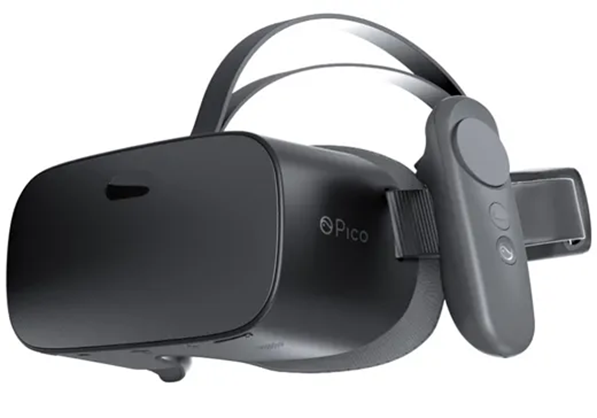
Paiduidao – Paiduidao is a Metaverse-like Social Network launched by ByteDance in January 2022 that enables users to interact in a virtual community utilizing avatars. The app was created by ByteDance’s subsidiary Beijing Shi Qu Wu Xian Technology Co. Ltd. It was released this week on the Chinese Android and iOS app marketplaces. (Source)
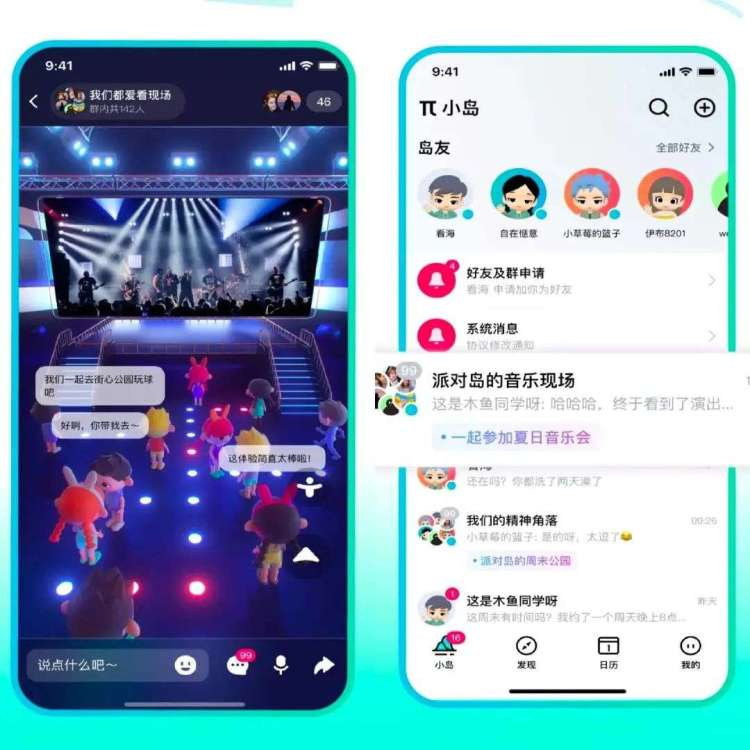
M&As Related to Metaverse
- In 2021, ByteDance made its first foray into virtual reality (VR) through the acquisition of a start-up called Pico. The acquisition was made for $772 million. (Source)
- Qualcomm announced a collaboration with Chinese unicorn ByteDance, owner of virtual reality (VR) headset manufacturer Pico Interactive, in March 2022, to seek improvements in metaverse-ready extended reality (XR) technology.
According to Cristiano Amon, President and Chief Executive of Qualcomm, “We’re collaborating on hardware and software to enable a global XR ecosystem.” (Source)(Source)
Strategy Related to The Metaverse
- Nuverse, ByteDance’s video games division, bought Shanghai-based gaming studio Moonton Technology for $4 billion in March 2021, as part of the company’s plan to grow further into the video games market.
According to ByteDance, “Through cross-team collaboration and drawing on lessons and insights from its own rapid growth, Moonton provides the strategic support needed to accelerate Nuverse’s global gaming offering.” (Source)
- In 2022, ByteDance made its entrance in Metaverse with its new social app, Party Island. The social networking program provides a parallel online realm in which users may meet up, chat, and attend events in real-time but through avatars rather than in person. (Source)
- ByteDance acquired the third-largest VR maker Pico in 2021, which appears to be a major move by Beijing-based ByteDance to supplant Facebook as the future metaverse engineer. (Source)
6. Tencent
Tencent made its debut in the metaverse by acquiring a 49% stake in the Roblox joint venture in 2019. Roblox is known for its ability to link people in virtual online worlds and to expand its function as the metaverse evolves. (Source)
Tencent took its Metaverse journey forward by investing $25 million in Lockwood Publishing, the producer of the 3D virtual environment Avakin Life, in November 2020. (Source)
In 2022, Tencent developed Huanhe, its own NFT platform. NFTs are sold on the marketplace in the form of video, audio, pictures, 3D models, and other formats. (Source)
Tencent Group planned to buy the Black Shark brand and integrate it with its Content Business Group in January 2022. The decision originates as the corporation seems to be preparing to explore the Metaverse. (Source)
Products Related to Metaverse
Huanhe – Tencent’s own NFT platform, Huanhe, was introduced in August 2021. NFTs are available for purchase on the market in the form of video, music, images, 3D models, and other forms.
According to Annabelle Huang, Partner at Amber Group, “Before May, a lot of the people in crypto in China were miners, and mining was a legitimate business mode. But since the ban and the great migration [of crypto miners from China], people are looking to the next thing. NFT itself is not an [initial coin offering], it’s not crypto pump-and-dump, so to speak, so I think the government, the regulator’s attitude, is more friendly.” (Source)(Source)
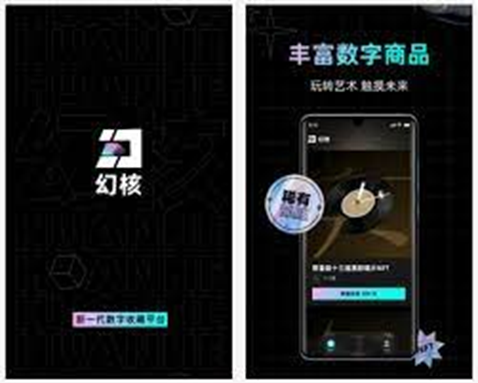
M&As Related to Metaverse
- Tencent Group announced its intention in January 2022 to purchase Xiaomi’s BlackShark Gaming business for around $470 million. The new agreement with Black Shark would center on collaboration in the realm of gaming phones, with the ultimate objective of providing customers with a better mobile gaming experience. (Source)(Source)
- In November 2020, Lockwood Publishing, the creator of the 3D virtual environment Avakin Life, received a $25 million investment from Tencent. Avakin Life has over 200 million registered users on iOS and Android, with over a million returning at least once a day. Previous investors Novator Partners, David Helgason, and Hilmar Pétursson also participated in the investment round. (Source)
Strategy Related to The Metaverse
Epic Games, Roblox, and Discord are Tencent’s portfolio firms that have already begun to flesh out some of the metaverse concepts. Tencent does not strive to accomplish everything on its own; instead, it has invested in hundreds of businesses that it believes have strategic value. Video games, Tencent’s greatest income generator, are the most apparent road to the metaverse.
According to Martin Lau, President at Tencent, “The driving force [of metaverse] will still be software-driven and the technology that really helps us to provide the user experience, be it engine technology, be it the ability to provide better, real experience, high-fidelity experience across many — a large number of concurrent users, AI technology, for example, in order to customize the different experience for different people.” (Source)(Source)
Metaverse Monetization Plans
Tencent believes that video games are the most apparent way of entering the Metaverse, which accounts for the majority of the company’s income. It might be extremely interactive games, multiple games under one common IP, or infrastructure that allows individuals to create games. (Source)
7. Samsung
On November 27, 2015, Samsung entered the metaverse with the launching of the headset. The Samsung Gear VR virtual reality headgear was conceived and produced by Samsung Electronics in collaboration with Oculus VR. This next-generation virtual reality provided users with the greatest VR experience. (Source)
Samsung’s Odyssey Windows Mixed Reality headset was released in 2017, providing users with true-to-life visuals and immersive experiences. Later in 2018, Samsung introduced a new and upgraded version of the headset, the Samsung HMD Odyssey+, which promised to bring lifelike experiences through the Windows Mixed Reality platform. (Source)
In January 2022, Samsung made a significant step toward the metaverse by releasing the 838X, an immersive environment that can be explored digitally. It debuted in Decentraland, a blockchain-powered metaverse, and is one of the biggest brand land takeovers in Decentraland. Fans would be captivated by a digital journey via the Connectivity Theater and Sustainability Forest to accomplish tasks for 837X Non-Fungible Token (NFT) badges, as well as a celebration at the Customization Stage. (Source)
Products Related to Metaverse
Samsung 837X – On January 6, 2022, Samsung Electronics America unveiled a virtual environment to explore, the Samsung 837X. Samsung’s new metaverse experience, modeled after the actual Samsung 837 flagship location in New York City, offers its spirit as an experiential playground for people to discover the astonishing possibilities when technology and culture intersect. (Source)

Samsung HMD Odyssey – In November 2017, Samsung released the first mixed reality headset, HMD Odyssey. Windows Mixed Reality, via the HMD Odyssey, replicates users’ movements in real life and allows them to share the experience with others. (Source)
In 2018, Samsung improved its Odyssey mixed-reality headset. The Samsung HMD Odyssey+, the updated iteration, promised to deliver lifelike experiences via the Windows Mixed Reality platform. (Source)
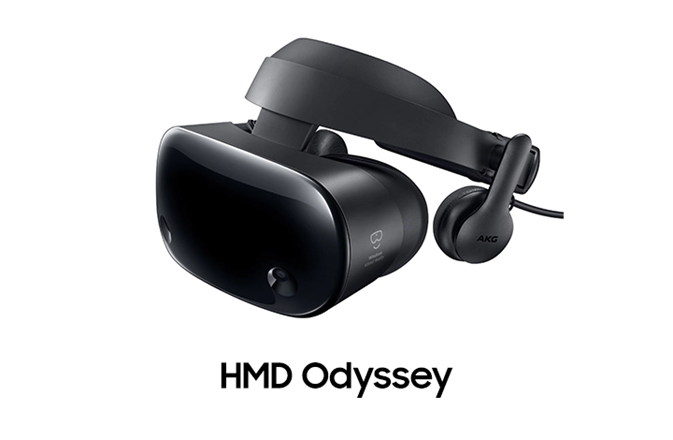
Samsung HMD Odyssey+

M&As Related to Metaverse
In August 2021, Samsung has onboarded South Korea’s government-led metaverse alliance in a move to strengthen partnerships in virtual reality (VR), augmented reality (AR), and artificial intelligence (AI) sectors.
According to the Ministry of Science and ICT (MSIT), a total of 202 firms are participating in the metaverse alliance with a number of new joiners that include Samsung. Other companies that have newly joined the alliance include Shinhan Bank, KB Kookmin Bank, SM Entertainment Co., MegaStudyEdu Co., and Cheil Worldwide. (Source)
Strategy Related to The Metaverse
Samsung is focusing on the metaverse and robotics as new development channels for future investments. The metaverse, AI, and robotics would move Samsung’s firm forward.
According to Han Jong-hee, Vice Chairman and Co-CEO of Samsung, in the company’s long-term aim in 2022, “We will develop optimized metaverse devices and solutions that will allow customers to experience the metaverse whenever and anywhere.” (Source)(Source)
8. Baidu
In 2016, Baidu took its first step toward the metaverse by launching DuSee, an augmented reality platform that allows Chinese smartphone users to explore smartphone augmented reality on their existing devices. (Source)
Baidu invested in 8i, a firm that makes holographic for VR and AR, and is stepping toward metaverse, in 2017.
Kitt.ai, a multi-platform natural language understanding engine to enable chatbots, and xPerception, which specialized in object recognition, and depth perception modules that could be used on robots and drones, were two of Baidu’s acquisitions in 2017. These would aid Baidu’s metaverse expansion. (Source)(Source)(Source)
Baidu even reached out to blockchain technology known as Xuperchain in January 2020 and announced XiRang, also known as Land of Hope, as the first locally manufactured metaverse in 2021. (Source)(Source)
Products Related to Metaverse
DuSee – In August 2016, Baidu, introduced DuSee, an AR platform that allowed China’s mobile users to try smartphone augmented reality on their existing devices. The business also stated that it intended to integrate the technology directly into its flagship products, including the widely used Mobile Baidu search engine. (Source)

XiRang – Baidu unveiled the first locally developed metaverse, XiRang, commonly known as Land of Hope, on December 2021. The virtual world, which is available as an application for computers, smartphones, and wearable devices, encourages Baidu users to log in and create an avatar to explore the environment and interact with other users. (Source)


Xuperchain – Baidu introduced its blockchain protocol Xuperchain in January 2020, on which enterprises and developers designed and deployed decentralized applications. It’s was Baidu’s most recent blockchain project for its metaverse. (Source)
M&As Related to Metaverse
Kitt.ai was acquired by Baidu in July 2017. It is a multi-platform natural language understanding engine that includes the Snowboy hot word detection engine and the Chatflow conversation engine. Kitt.ai was created to support chatbots, but it also had direct applicability to voice applications. (Source)
Baidu purchased xPerception, a computer vision firm based in the United States, in 2017. xPerception gives object recognition and depth perception module that may be used on robots and drones. (Source)
Patent Activity Related to Metaverse or AR/VR
According to Wisdom Bud data, as of the latest, Baidu and its affiliates have a total of 193 Metaverse-related patent applications in 126 countries/regions. (Source)
Baidu, China’s search giant has filed 3,094 VR and AR patent applications in the past two years (2020 and 2021). (Source)
Strategy Related to The Metaverse
Baidu planned to hold its annual developers’ conference remotely on its XiRang app, making it China’s first metaverse conference. Baidu announced in December 2021 that its metaverse could take up to six years to be completely operational and up to par. Last year, the Beijing-based firm began work on its XiRang metaverse software.
According to Baidu’s Vice President Ma Jie, the application’s full rollout will take ‘negative six’ years. (Source)
9. MagicLeap
Magic leap catapulted its tech into the public in 2014 after receiving funding from wearable AR pioneers Google. They were working on some cutting-edge augmented reality technology at the time, and it was the beginning of a Magic journey into the metaverse.
In August 2018, Magic Leap released its 1st augmented reality headset.
Magic Leap revealed in 2019 that it had purchased a 3D branch of Dacuda that specialized in developing algorithms to capture 2D and 3D imagery in real time.
In May 2019, Magic Leap announced the acquisition of Mimesys, a Belgian company that allows Magic Leap One users to participate in real-time telepresence conference calls using volumetrically captured avatars that look like their real bodies.
Magic Leap 2 was revealed in February 2021. It was claimed to be a significant upgrade over the previous iteration, with more vibrant graphics, and is supposed to be launched in 2022. (Source)(Source)(Source)(Source)(Source)
Products Related to Metaverse
Magic Leap 1 – Released in August 2018, it is an augmented reality headset that appears almost similarly to prior devices. It has a transparent front that allows the wearer to see the world around them, onboard projectors for projecting AR pictures to the wearer, sensors for determining the user’s location in space, and onboard speakers. (Source)(Source)

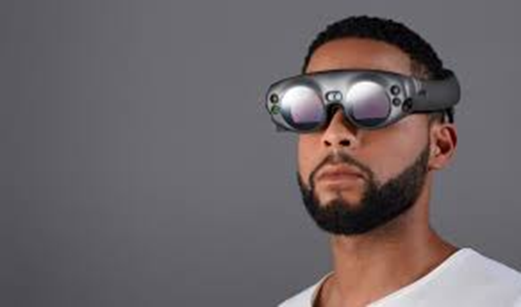
Magic Leap 2 – It is an augmented reality headset by Magic Leap . It was announced in February 2021 and released in September 2022. The Magic Leap 2 is also said to have better color, text, and image quality. It is Enterprise-ready, as light as a pair of headphones, and ergonomically engineered to handle current Manufacturing, Health, and Defense applications, among others. (Source)(Source)
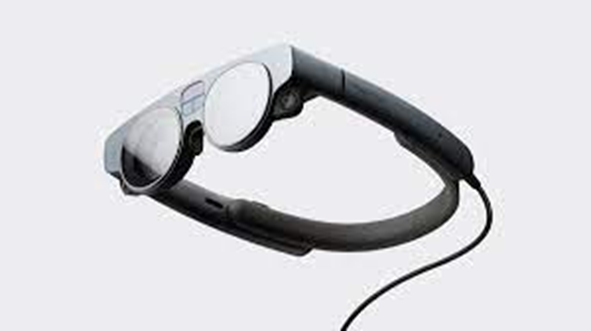
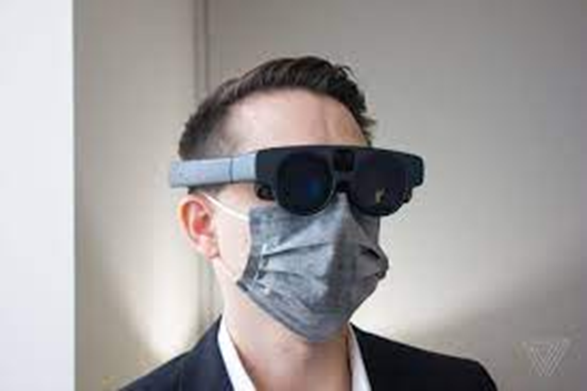
Mica – In 2018, Mica unveiled A human-like AI in augmented reality, Mica. The AI emerged as a perfect interface to human-centered AI that elicits natural responses from people. Mica manages to deliver the interactions and intelligence that users demand. (Source)
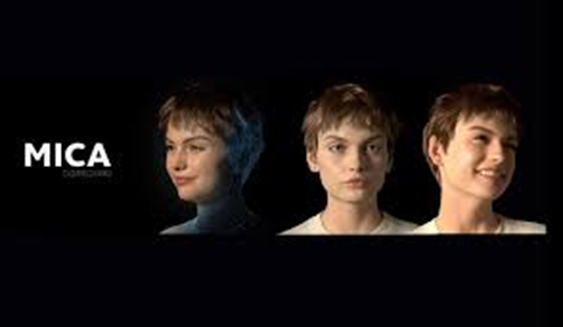

M&As Related to Metaverse
- In 2017, Magic Leap purchased the 3D branch of Dacuda, a Zurich-based computer vision firm. Dacuda’s primary focus had been on developing algorithms for consumer-grade cameras (and not only cameras but any device with a camera function) to capture 2D and 3D imaging in real-time, ‘making 3D content as simple as making a movie.’ (Source)
- In 2019, Magic Leap acquired Mimesys for undisclosed amount.
According to Omar Khan, Magic Leap’s Chief Product Officer, “The spatial co-presence platform the Mimesys team has created is remarkable and we are thrilled to have them as part of our team. We look forward to further expansion of co-presence and collaboration tools on the Magic Leap platform.” (Source)
Metaverse Monetization Plans
Magic Leap’s strategy for making money in the metaverse began in 2018 with the release of a refined AR device. Later, it raised further funds and announced plans to release the Magic Leap 2 in early 2022. By offering its AR devices, the company also intends to target the defense, healthcare, and industrial manufacturing sectors. (Source)
10. Roblox
The company began its Metaverse quest in April 2016 with the release of Roblox for Oculus Rift VR, which introduced 3D games.
Roblox announced the creation of ‘Party Place’ in July 2020, which serves as an online hangout. The feature was devised in response to the COVID-19 epidemic and was created using new technologies that had been used during the 2020 Bloxy Awards.
Roblox formed many collaborations in 2021 to help the metaverse flourish, including one with Sony Music Entertainment to provide virtual entertainment and another with Nike to create Nikeland, a virtual play zone. (Source)(Source)(Source)(Source)
Products Related to Metaverse
Roblox VR for Oculus Rift – ROBLOX officially entered the world of virtual reality in 2016 with the launch on Oculus Rift. Roblox VR Supported games are created with both flat-screen and VR players in mind. These games are playable on VR hardware as well as any other gaming device supported by Roblox.
The ROBLOX experience on Oculus Rift is comparable to that of other ROBLOX platforms. It is totally cross-platform, which means that if users are using Oculus Rift, a friend is using a PC, and another friend is using a mobile, they may all join the same gaming server. No other Oculus Rift game or VR technology provides that level of connectivity. (Source)(Source)
Roblox VR on Oculus Rift


Party Place – The Metaverse company introduced a new feature named ‘Party Place’ in July 2020 to directly address the rising demand among users for a dedicated, private space to conduct virtual gatherings. The new ‘Party Place’ location is based on technologies developed by the game firm to support its own virtual events, such as the 7th Annual Bloxy Awards and the One World: Together at Home concert.
According to the its website, the product is in beta testing and has received just over 45.3,000 visitors in the first week since its inception. (Source)
Roblox Party Place

M&As Related to Metaverse
- In July 2021, Roblox and Sony Music Entertainment announced a strategic partnership that brought more Sony Music recording artists onto the Roblox metaverse. Under the terms of the agreement, Roblox and Sony Music collaborated to create innovative music experiences for the Roblox community that would provide a variety of new commercial opportunities for Sony Music artists to reach new audiences and generate new revenue streams around virtual entertainment. (Source)
- Nike announced a deal with the Metaverse company in November 2021 to create a free virtual playspace dubbed Nikeland. Nikeland offers minigames such as tag and dodgeball, as well as, a lava floor that players can explore with their pals. Users can utilize their phones to convert real-life movement into the game through mobile integration. (Source)
- Roblox revealed in August 2021 that they had purchased Guilded, a Discord competitor who had been developing a chat network for competitive players. (Source)
Strategy Related to The Metaverse
Roblox’s international expansion plans are already in the pipeline. On May 28, 2019, the firm formed a strategic agreement with Tencent, a Chinese global technology conglomerate. As part of the arrangement, it’d introduce its Chinese equivalent, LuoBu, to mainland China.
75% of Roblox’s engineering team has concentrated on enhancing performance to enable larger, more technically-impressive games, as well as a new lighting engine, in order to increase the platform’s developer appeal.
The company is also aiming on attracting smaller, 5–20-person video game studios that may have struggled to produce financially successful games on other, more competitive platforms like the IOS App Store. (Source)
Metaverse Monetization Plans
The majority of Roblox’s revenue comes from the selling of its digital currency, Robux. Developers on the platform make money by swapping their Robux for USD. This strategy provides a strong motivation for game creators to continue expanding and developing their games (in order to earn more Robux from players), as well as for the company to offer features for developers (so more users will come). This incentive system has generated a flywheel effect for the company’s growth, allowing it to grow indefinitely without the need for new stimulus. (Source)
Conclusion
Meta’s recent announcement of a huge R&D investment in its VR gadget including startup acquisitions saw criticism among the tech people. The company is losing billions of dollars but Mark’s attitude toward Metaverse hasn’t changed. Zuckerberg said he expects those losses to keep piling up as he continues the work of building out the metaverse, even as investors’ concerns mount over a lack of progress.
A blessing in disguise for Meta came via a user’s positive remarks regarding its platform, Horizon Worlds. (Source)
“It’s been an incredibly positive experience and one of the best in my life,” says Aaron Sorrels, a 47-year-old professional comedian who opened a virtual comedy club in Meta’s flagship metaverse platform, Horizon Worlds, last year.
These word-of-mouth reviews are quite effective and especially when there is money involved. If Meta or any other company will make these Virtual Worlds a positive environment for social or business interaction that provides some kind of rewards to users, Metaverse could see a huge turnaround in the coming years.
Apart from these tech giants, Metaverse is also seeing a surge in startups working on it. And companies are heavily investing and acquiring these startups for fast growth.
In the next article, we have discussed over 20 leading Metaverse Startups.
Want to know about these Metaverse companies and startups in detail?
Authored By: Vipin Singh, Market Research
Edited By: Nidhi, Marketing











